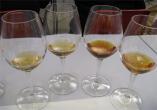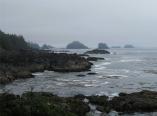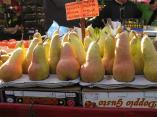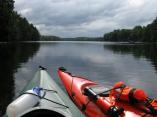Seafood is as confusing a topic as any these days. Trying to get to the bottom of what is and isn’t a good choice of seafood is baffling and contradictory. Here’s an attractive guide for Europeans from The Guardian; and here’s some information from the Suzuki Foundation, complete with informative videos and links to sustainable seafood lists, adapted to different geographies.
But is it as simple as eating only this or that fish, when they do not exist in isolation? Humans are persistent in choosing to believe they can pick and choose from nature with no effect on its complex interrelationships. There is a whole aquatic food chain involved, and deeply affected by our choices; eating our way through multiple links in it is bound to cause unknown effects on all the ocean’s stocks.
Today I listened to a report on NPR about a study of acidity in the coastal waters just south of Victoria. It seems CO2 emissions are being absorbed at such a rate by our oceans that they are turning acidic much faster than supposed, bad news for acid-sensitive marine life like mussels, while ideal for acid-friendly life forms like algae; and down the line will corrode the shells and kill off other vulnerable shellfish including coral and plankton, way down at the bottom of the food chain – and what more important place is there? (Lots more on this in a 2006 report called Impacts of ocean acidification on coral reefs and other marine calcifiers)
Meanwhile, the Canadian Food Inspection Agency has published a new and interesting page of information for people wishing to peddle so-called “novel fish and fish products” in this country. Novelty is not so cosy a word as it used to be; nowadays this is food-regulation-speak for genetically modified and otherwise oddly manipulated food items. (A list of the “novel food decisions” going back to 1994 makes for uneasy reading.)
This led me down some time consuming side-tracks… I find myself wondering if the appearance of this information sheet might herald some potential movement on Canada’s part in allowing genetically engineered fish to be farmed here, just as the FDA has offered up some procedures for companies wanting to market genetically modified animal products in the US; and what happens next door usually spills across our border without a fight or much delay at all.
The 2008 March Status Report of the Commissioner of the Environment and Sustainable Development hints that this might be coming, even as it states that this country has no intention of developing a policy on transgenic aquatic organisms because it feels that the Canadian Environmental Protection Act, 1999 (with its Animate products of biotechnology section, and the Domestic Substances List (DSL)) covers the matter nicely thank you. Lots of reading there for interested parties.
And the complexity of all of that regulatory verbage explains why most of us haven’t a clue what genetically modified foodstuffs are and aren’t being fed to us; unfortunately for us, the politicians are as confused as the rest of us. And this CBC story from 2002 is as mercilessly true today as it was when it was broadcast. Beans and rice for supper, I think…
Anyway. Nancy Willard has written a great tribute to seafood in A Wreath to the Fish.









0 Responses to The future of fish